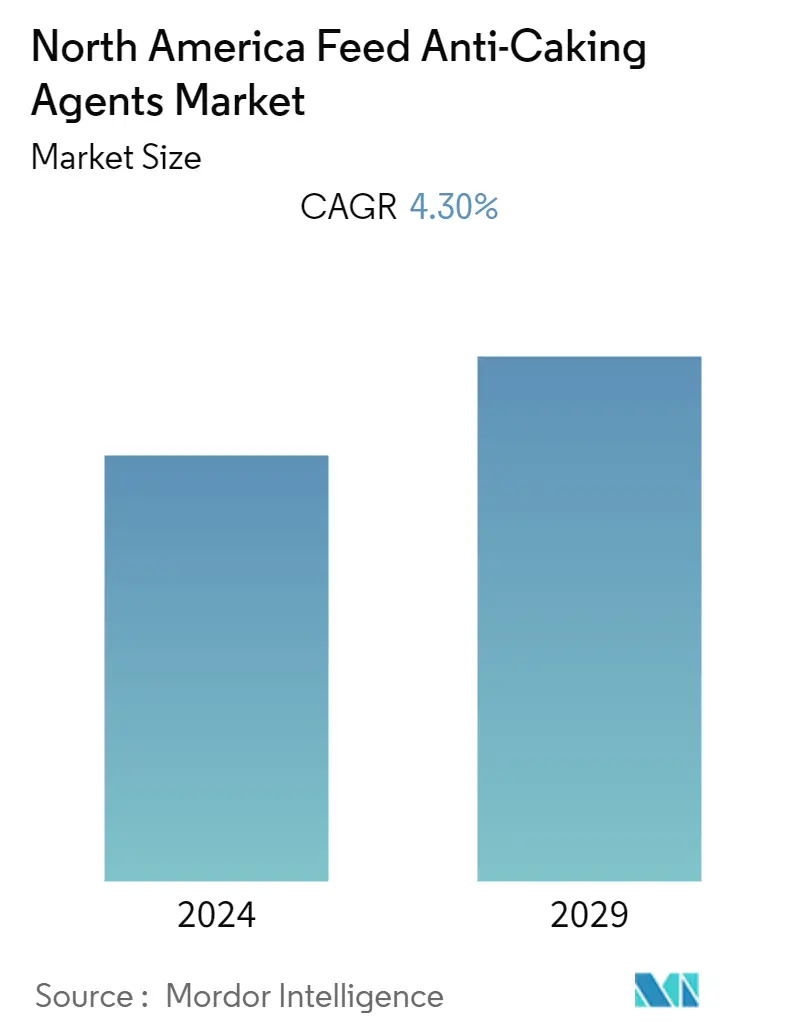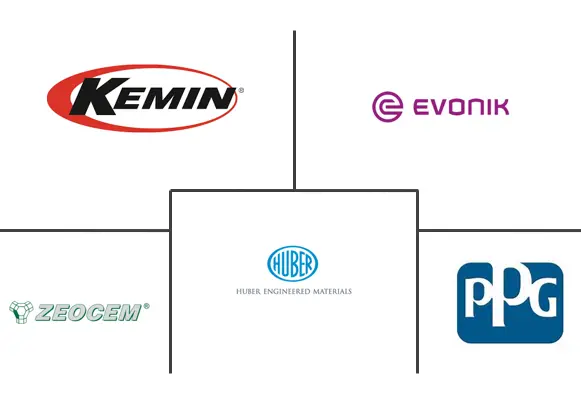Market Size of North America Feed Anti-Caking Agents Industry

| Study Period | 2019 - 2029 |
| Base Year For Estimation | 2023 |
| Forecast Data Period | 2024 - 2029 |
| Historical Data Period | 2019 - 2022 |
| CAGR | 4.30 % |
| Market Concentration | Medium |
Major Players
*Disclaimer: Major Players sorted in no particular order |
North America Feed Anti-Caking Agents Market Analysis
North America Feed anti-caking agents Market is projected to register a CAGR of 4.3% during the forecast period (2020-2025). North America is the biggest and vital market for the production and consumption of anti-caking agents. The United States is recorded as the largest producer and consumer of the market, due to the high demand for feed in the region. The country is also one of the major exporters of feed anticaking agent to the other countries in the region. Feed anti-caking agents along with other feed additives have seen a spur in demand, due to the requirement of high-quality feed for the livestock. This resulted in establishing a huge number of firms and has ended up dominating the market. The regulatory framework is uncertain and is, therefore, dampening the growth of the market. The export to other countries with free trade laws in place is an opportunity for the market. The major drivers for this market include the rapid growth of the livestock sector, expansion of the animal feed market, rising demand for the use of high-quality feed, and an increase in the number of feed additives.
North America Feed Anti-Caking Agents Industry Segmentation
An anti-caking agent is an additive that is used in the feed industry to avoid the formation of lumps. They are used to prevent the naturally occurring fungal metabolites and improve feed quality. They provide a better solution for moisture adsorption, nitrogen loss, and caking in granulated which is caused by mold growth. Furthermore, the feed anti-caking agents are utilized to provide better and optimum packaging systems which make transportation simpler.
| By Type | |
| Silicon based | |
| Sodium based | |
| Calcium based | |
| Potassium based | |
| Other Chemical Types |
| Animal Type | |
| Ruminant | |
| Poultry | |
| Swine | |
| Aquaculture | |
| Other Animal Types |
| Geography | |
| United States | |
| Canada | |
| Mexico | |
| Rest of North America |
North America Feed Anti-Caking Agents Market Size Summary
The North America feed anti-caking agent market is a significant segment within the broader animal feed industry, driven by the increasing demand for high-quality livestock feed. The United States stands out as the largest producer and consumer in this market, largely due to its substantial feed production and export activities. The growth of the livestock sector, coupled with the expansion of the animal feed market, has spurred the demand for feed anti-caking agents. These agents are essential in preventing caking and agglomeration in feed, thereby enhancing the flow and quality of feed ingredients. Despite the promising growth prospects, the market faces challenges from an uncertain regulatory framework, which could potentially hinder its expansion.
The market landscape is characterized by high competition, with numerous small and medium-sized enterprises alongside a few major players vying for market share. Companies are not only competing on product quality and promotional efforts but are also engaging in strategic initiatives such as new product launches, partnerships, and acquisitions to strengthen their market position. The presence of free trade laws presents an opportunity for further market growth through exports to other countries. As the demand for animal protein continues to rise, the feed anti-caking agent market in North America is expected to maintain a positive growth trajectory during the forecast period.
North America Feed Anti-Caking Agents Market Size - Table of Contents
-
1. MARKET DYNAMICS
-
1.1 Market Overview
-
1.2 Market Drivers
-
1.3 Market Restraints
-
1.4 Porters Five Forces Analysis
-
1.4.1 Bargaining Power of Suppliers
-
1.4.2 Bargaining Power of Buyers/Consumers
-
1.4.3 Threat of New Entrants
-
1.4.4 Threat of Substitute Products
-
1.4.5 Intensity of Competitive Rivalry
-
-
-
2. MARKET SEGMENTATION
-
2.1 By Type
-
2.1.1 Silicon based
-
2.1.2 Sodium based
-
2.1.3 Calcium based
-
2.1.4 Potassium based
-
2.1.5 Other Chemical Types
-
-
2.2 Animal Type
-
2.2.1 Ruminant
-
2.2.2 Poultry
-
2.2.3 Swine
-
2.2.4 Aquaculture
-
2.2.5 Other Animal Types
-
-
2.3 Geography
-
2.3.1 United States
-
2.3.2 Canada
-
2.3.3 Mexico
-
2.3.4 Rest of North America
-
-
North America Feed Anti-Caking Agents Market Size FAQs
What is the current North America Feed Anti-Caking Agents Market size?
The North America Feed Anti-Caking Agents Market is projected to register a CAGR of 4.30% during the forecast period (2024-2029)
Who are the key players in North America Feed Anti-Caking Agents Market?
PPG Silica Products, Solvay SA, ZEOCEM, Evonik Industries and Kemin Industries Inc are the major companies operating in the North America Feed Anti-Caking Agents Market.

